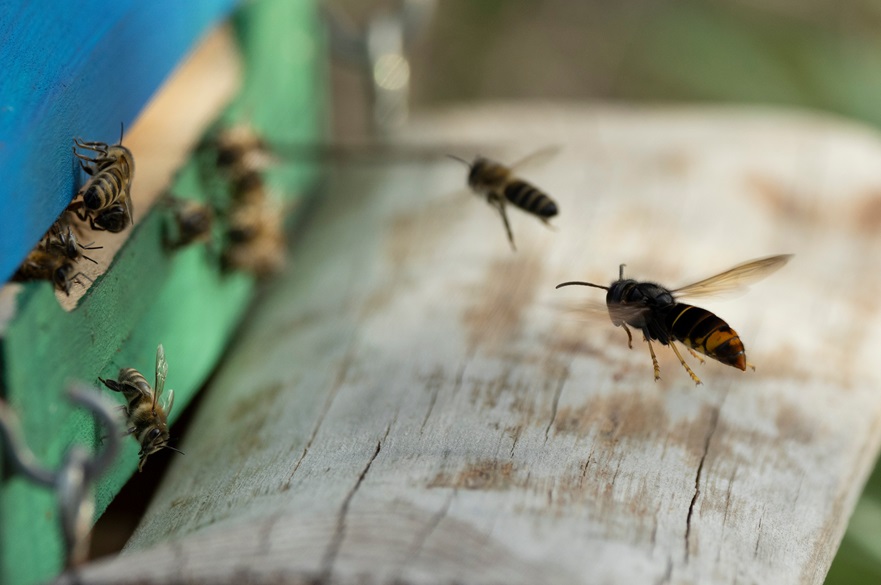Scientists have been able to remotely detect, capture and analyse the sound of the invasive Asian hornet in flight, in a move which could help save honeybee colonies from distress and destruction.

The Nottingham Trent University team are the first to characterise and differentiate Asian hornet from honeybee hovering flight sounds, using microphones and machine learning techniques capable of automatically identifying the predator as soon as it arrives at an apiary.
As part of their study the researchers, in close collaboration with scientists from the University of Coimbra in Portugal and Ghent University in Belgium, were able to detect hornet presence when there was just one individual in the vicinity of a hive.
Asian hornets are an invasive species which has been spreading across Europe since 2004 and was first sighted in the UK in 2016.
Honeybees are one of the main food sources of the Asian hornet, which capture and eat bees moving in and out of the hive on foraging trips.
The hornets seriously impact colonies as the bees become so stressed by their presence around the hive that they reduce, or in some cases completely stop their foraging activities.
Because the bees are too terrified to leave to collect resources, they enter the winter period with smaller food stores, which puts the survival of the colony at risk.
Unlike Asian honeybees, European honeybees have not co-evolved with the hornets and so they lack practice or experience in defending themselves against the threat.
As part of the pilot study the researchers were able to reveal repeating features in the flight sounds – or wingbeat frequencies – of Asian hornets and honeybees specifically linked to their hovering.
They also found that the hornet reliably produced these features as they tend to hover continuously, while honeybee hovering is much shorter in duration as they are mostly coming in and out of the hive with little or no hovering at all.
Using an inexpensive microphone, paired with the team’s algorithm, the team was able to detect the presence of Asian hornets at an apiary at the University of Coimbra in Portugal with almost 100% accuracy over three seasons.
They are now working towards a follow-up study using longer-term data to further develop their method.
The researchers argue their system could be left in apiaries long-term to continuously distinguish between Asian hornet and honeybee flight sounds.
This could allow beekeepers to be immediately alerted to hornet presence, even just one individual, via their smartphone and enable them to quickly enforce hornet control methods before too much distress is caused to colonies.
Currently, Asian hornet monitoring is costly and time-consuming. They are identified and controlled using ‘in-person’ techniques such as citizen science schemes and nest detection methods, which involves people walking around on foot and using thermal cameras to spot nests in trees for future destruction.
“Invasive species such as the Asian hornet are a serious threat to biodiversity,” said lead researcher Dr Harriet Hall.
She said: “Our native honeybee hasn’t evolved alongside this predator and because of this its defences against the hornet are low. Identifying Asian hornet presence at apiaries early on would be highly beneficial for beekeepers who could then take immediate action.
“We have been able to discriminate between Asian hornet and honeybee sound data and this provides excellent potential for use as a remote alert system for hornets, where beekeepers could be immediately alerted that hornets have arrived.”
Dr Martin Bencsik, a physicist at Nottingham Trent University, said: “Asian hornets are a significant threat to European honeybees and we need to find new ways to identify their presence quickly. In spite of overlapping features of the sound spectra of honeybees and hornets, it is amazing to see that their hovering sound features are very different, and it is fortunate, for this detection technique, that hornets hover around hives far more than bees do.”
In 2023 the Nottingham team revealed how a tiny parasitic honeybee mite had a distinctive walk – and that by listening for the unique vibration caused by its stride pattern it could help them spot if it is infesting a hive.
The latest study is published in the journal Computers and Electronics in Agriculture.
This project receives funding from the European Union’s Horizon 2020 research and innovation programme as part of the Giving Beekeeping Guidance by cOmputatiOnal-assisted Decision making (B-GOOD) consortium under grant agreement No. 817622.
